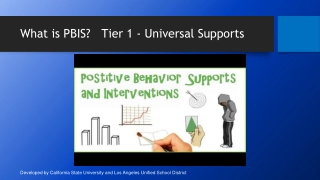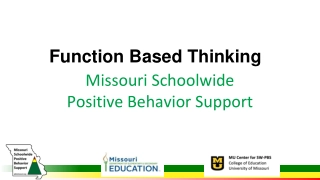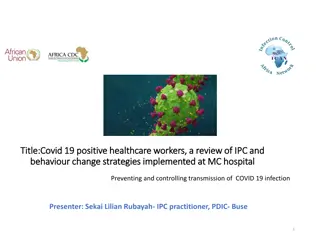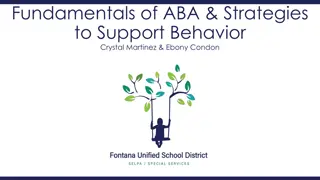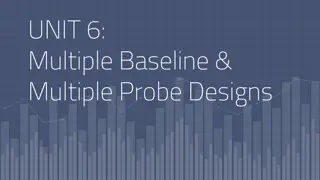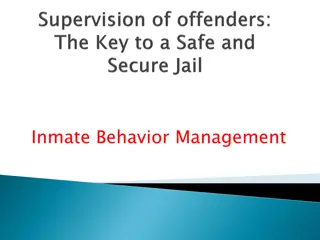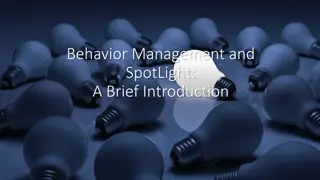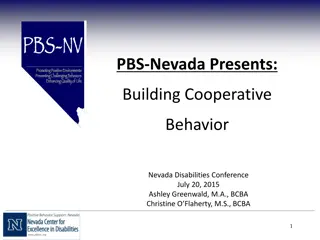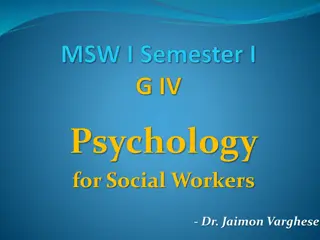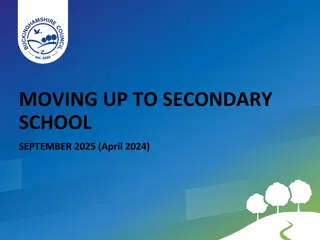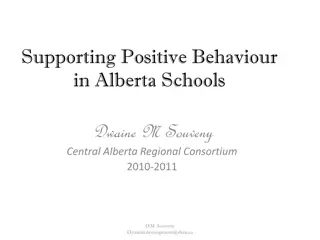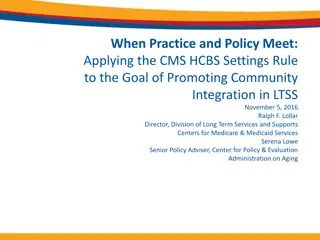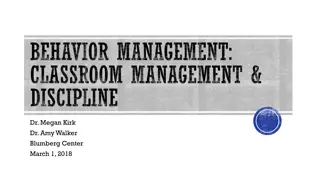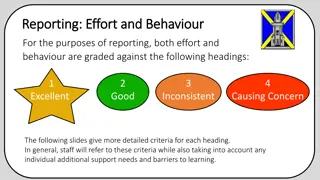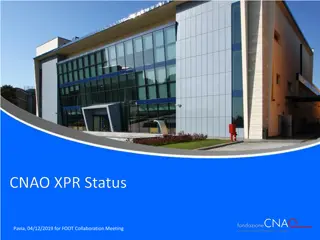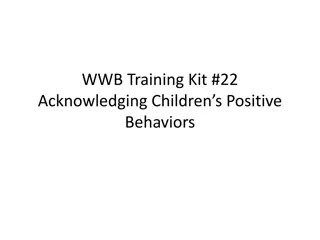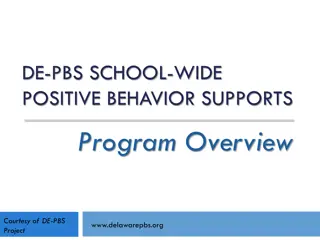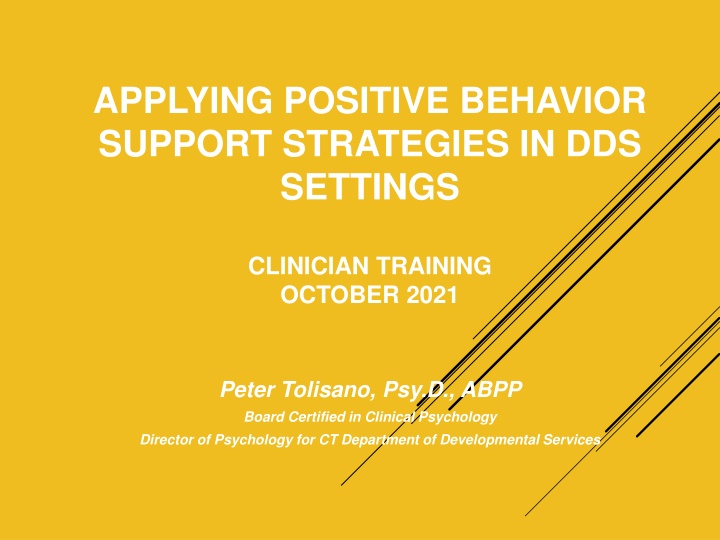
Applying Positive Behavior Support Strategies in DDS Settings
A comprehensive approach emphasizing individual and team collaboration, Positive Behavior Support (PBS) recognizes behaviors as interconnected with various factors. Developed by Rob Horner and George Sugai, PBS focuses on proactive and reactive strategies, team collaboration, and data collection to inform practice. It aligns with the DDS mission of supporting individuals and families, emphasizing strengths, lifelong planning, and creating meaningful opportunities.
Download Presentation

Please find below an Image/Link to download the presentation.
The content on the website is provided AS IS for your information and personal use only. It may not be sold, licensed, or shared on other websites without obtaining consent from the author. If you encounter any issues during the download, it is possible that the publisher has removed the file from their server.
You are allowed to download the files provided on this website for personal or commercial use, subject to the condition that they are used lawfully. All files are the property of their respective owners.
The content on the website is provided AS IS for your information and personal use only. It may not be sold, licensed, or shared on other websites without obtaining consent from the author.
E N D
Presentation Transcript
APPLYING POSITIVE BEHAVIOR SUPPORT STRATEGIES IN DDS SETTINGS CLINICIAN TRAINING OCTOBER 2021 Peter Tolisano, Psy.D., ABPP Board Certified in Clinical Psychology Director of Psychology for CT Department of Developmental Services
GOALS OF THE PRESENTATION Appreciate the contributions that underpin a PBS approach Understand the ways in which brain functioning and context influence behavior Understand how all behaviors serve a function Increase knowledge about proactive and reactive strategies See the value of team collaboration and data collection to inform practice and prescribing
What is PBS? A comprehensive approach that is individual- and team-driven, which views behaviors as goal-directed and interconnected with physiology, situational context, cultural factors, as well as an individual s past history and current thoughts and feelings. It differs from the expert-driven medical model that views behaviors as generally linked to diagnosis. It was developed by Rob Horner and George Sugai around 1990. Relates to Applied Behavioral Analysis, but has broader applicability
Positive Behavioral Supports Why use PBS with the individuals we support ? What are the benefits? Humanistic Ethical Best Practices (Evidence-Based and Data-Driven) Accountability Sustainability
PBS fits with the DDS Mission Partner Partner with individuals and families with individuals and families Support Support lifelong lifelong planning planning Create meaningful Create meaningful opportunities V Valued members of their alued members of their communities Emphasizes Emphasizes p personal strengths ersonal strengths opportunities communities and Vision and Vision Have safe, meaningful, and empowering relationships. Have safe, meaningful, and empowering relationships. Have families who feel supported from the earliest years and Have families who feel supported from the earliest years and throughout their lifetimes. throughout their lifetimes. Have lifelong opportunities and the assistance to learn things that Have lifelong opportunities and the assistance to learn things that matter to them. matter to them. Make informed choices and take responsibility for their lives and Make informed choices and take responsibility for their lives and experience the dignity of risk. experience the dignity of risk. Know their rights and responsibilities and pursue opportunities to live Know their rights and responsibilities and pursue opportunities to live the life they choose. the life they choose.
Formal Definition of Positive Behavior Support Formal Definition of Positive Behavior Support: : Research-based strategies to increase quality of life, decrease problem behavior by teaching new skills, and changing a person's environment. NASDDDS Four Components NASDDDS Four Components: : 1. Valued Outcomes Valued Outcomes Unique preferences and needs to enhance personal satisfaction. 1. 2. Behavioral and Biomedical Science Behavioral and Biomedical Science Recognize individual history including trauma, medical issues, psychiatric state, and significant relationships to understand the factors influencing behavior. 2. 3. Validated Procedures Validated Procedures Data collected to measure outcomes includes program evaluation, surveys, interviews, rating scales, direct observation, and self-report information. 3. 4. Systems Change Systems Change PBS strategies consider the home or organizational environment to ensure the success. Factors include staff development, team building, and fit between the plan and those who will implement it. 4.
Physiology: Regions of the Brain The brain has three main parts: Brainstem that controls vital physical functions and survival responses. Limbic system that governs emotions, anxiety, and at times behaviors. The low road. Frontal cortex for higher-order thinking and executive functions: These include a sense of time and context, planning, thinking flexibly, decision- making, inhibiting and initiating action, self-monitoring, and empathic understanding. The high road. 7 Limbic system versus Frontal cortex: The horse and the rider metaphor.
Physiology: Parts of the Limbic System Amygdala a binary organ that detects threat (fight, flight, freeze, and fawn reactions). Powerful controller of behavior! Hippocampus for memory storage (especially trauma-related ones) Hypothalamus relays sensory information and activates the autonomic nervous and endocrine systems (e.g., adrenaline and cortisol stress hormones) Brief Exercise the power of the amygdala
Positive Behavior Support Support for Positive Behavior Support = Encouraging, increasing, and strengthening Positive Behavior = desirable, adaptive, and prosocial Avoids the use of aversive, humiliating, or stigmatizing interventions
The Key Components of Positive Behavior Support Minimize or eliminate environmental triggers Proactive setting of expectations Functional Assessment of Behavior Teaching acceptable behaviors Building on existing appropriate behaviors Improving quality of life Fidelity with implementation Consistency with supports
Positive Behavioral Supports Adaptive and Prosocial Behaviors: Enhance Progress Maladaptive Behaviors: Interfere with Growth and Development
Positive Behavior Support Terminology Targeted Positive Behaviors: To achieve, instill, increase, and maintain Increase emotional regulation through coping strategies, self-soothing, healthy diversions, and opportunities to learn self-control. Become more adaptive and self-reliant by building autonomy, mastery, confidence, and self-direction. Increase prosocial skills and participation in community activities
Positive Behavior Support Terminology Behaviors of Concern: those to decrease or eliminate. These include verbal outbursts, physical aggression, property destruction, perseveration, poor boundaries, and refusals. Criteria for what constitutes a Behavior of Concern: Interferes with his or her growth, development, or progress. Interferes with his or her ability to make decisions and to achieve goals. Results in a psychotropic medication being prescribed to modify the behavior. Poses a risk to the health and safety of the individual and others.
Positive Behavior Support Learning the function through context Topography of Behavior(s) Consensus on descriptions and labels Setting Events and Vulnerabilities Situations in the environment combined with individual s deficits. We can create positive setting events! Antecedents (or Triggers) What occurred immediately before the behavior? Fast vs. slow precipitants? External (e.g., a conflict earlier in the day) vs. Internal antecedents (e.g., feeling lonely and disappointed) The universal trigger is often enforcing rules rather than thinking flexibly when giving direction and guidance. Precursors What noticeable actions in body language came before the behavior of concern? (e.g., pacing, pressured speech, rolling their eyes, clinching their fists) Maintaining Consequences What occurred immediately after the behavior of concern? How did the caregivers respond? Is there inadvertent reinforcement?
Behavior serves a particular function for the individual, which we determine through a Functional Assessment of Behavior. Examples of the Initial Broad Categories: Intrapersonal Reinforcement (e.g., emotional reinforcement) or Interpersonal Reinforcement (e.g., help-seeking behavior) Positive or Negative Reinforcement Function Function The realization that every behavior has a purpose The realization that every behavior has a purpose an underlying reason for why it occurs as related to context and patterns. why it occurs as related to context and patterns. an underlying reason for Once we identify the function, we can design interventions directly targeting Once we identify the function, we can design interventions directly targeting the reason(s). the reason(s). There needs to be correspondence between the identified There needs to be correspondence between the identified function and the recommended intervention! function and the recommended intervention!
Functional Assessment of Behavior BETTER UNDERSTANDING WHY INDIVIDUALS ENGAGE IN MALADAPTIVE BEHAVIORS (ROBERT SOUVNER, 1991) Possible Functions of Maladaptive Behavior Modulates Internal Distress Modulates Physical Distress Socio- Environmental Control Communication
Functional Assessment of Behavior Be aware that functions differ for each individual. Some might be readily apparent and others might not be noticeable (e.g., limbically vs. cortically-driven) Behaviors might serve multiple functions In DDS, we see an over-application of attention-seeking, manipulation, escape, and avoidance as identified functions of behavior.
Helpful PBS Questions Does the person-served: o Understand the behavioral expectations for the situation? o Realize that he or she is engaging in unacceptable behavior? o Know that the problem behavior associated with certain environmental conditions? For example, who is present when the behavior takes place or immediately after the behavior? General Solution-Focused Inquiries: o What has worked in the past to help stabilize behavior versus what has not? What was the person-served thinking and feeling before the behavior of concern? o Is it within the person s ability to control (i.e., inhibit impulses) the behavior? o Can the person-served identify acceptable behaviors to replace the maladaptive behavior? o o Does the person-served have the skills necessary to perform the new behavior? What modifications to the environment that have been tried to reduce problem behaviors and support more adaptive behaviors? o
Key Points about Development and Behavior In the context of I/DD, behavioral problems often related to challenges in delaying gratification, controlling impulses, and tolerating frustration. The best approach is building on cognitive strengths and minimizing weaknesses. For example, providing information using pictures, rather than words, to someone with visual-spatial strengths and verbal limitations. Look for mental health difficulties (e.g., unusual behaviors, poor reality testing, fight or flight responses related to past trauma) Self-protective responses may not be intended as aggressive.
Key Points about Development and Behavior Don t assume that the person is intentionally trying to be difficult, as some challenges might be out of their control. For example, memory deficits might lead to problems understanding multi-step directions. Look for signs of psychosocial masking (e.g., nodding in agreement, politely agreeing) to adaptively conceal impairments. Behavioral problems may or may not be related to mental health issues, as I/DD can lead to diagnostic overshadowing bias.
Stage of Change Model Precontemplation: Characterized by denial, poor awareness, or rebellion. Contemplation: Ambivalent feelings of pros and cons about the behavior. Explore function of the behavior. Avoid dwelling on consequences. Preparation: Taking proactive steps about imminent change. Thinking about a concrete plan within 30 days. Action: Demonstrate a commitment to a plan in real life. Maintenance: Staying changed for 3 to 6 months. Focus on relapse prevention skills. General Considerations: People change into and out of behaviors, so progress takes time. Vacillate between stages and phases of each. Avoid suggesting an action-oriented strategy to someone who is precontemplative or contemplative, as it s a therapeutic mismatch!
Positive Behavioral Supports Individual Challenges What gets in the way? Difficulty learning new behaviors due to cognitive deficits. Problem behaviors habitually work in meeting their needs. Problem behavior is rooted in trauma. Amelioration of psychiatric symptoms is needed Unwilling or unmotivated to engage in positive behavior due to personality dysfunction Unfortunately, some individuals are not candidates to receive PBS (e.g., sociopathy, refractory psychosis)
Examples of Positive Ways to Help Change Behavior Prompting Operant Conditioning Role Modeling Teaching Skills Building Positive Identity
Positive Behavior Support Overarching Goal Our aim is the presence of targeted adaptive and prosocial behaviors through instruction and reinforcement, not just the absence of challenging behavior.
Staff and Caregiver Qualities that are Consistent with PBS Supportive Respectful Strengths-based Collaborative Empowering Give choices Build self-esteem Believe in them! (It s a key factor for resiliency)
PBS Communication Tips Language Speak clearly and softly using short phrases. Show interest and concern. Give concrete directions in one or two steps at a time. Describe what you will be doing beforehand. Avoid slang expressions, idioms, and metaphors (e.g., knock it off, cut it out, act appropriately, or settle down ). Watch for words that trigger agitation, such as If/then statements, as the person might not think contingencies are achievable.
PBS Communication Tips Language Ask the person to repeat back information or demonstrate something to check for understanding. Try other ways to communicate, such as pictures and cues. Always speak respectfully in the person s presence. Use person-first language (e.g., An individual with challenges). Share what you learn about the person with others who will be assisting. Allow them extra time to process and respond. Have realistic expectations. Be consistent with language, especially between responders. Rephrase questions or restate directives as needed. Use specific directives; avoid assumptions
Applying Other Behavioral Strategies Choices Offer two to three choices when possible provides the person with a sense of control. These choices may lead to a similar outcomes (e.g., de-escalation). Be mindful that overly negotiating may lead to confusion. Reinforcement Give verbal praise immediately and explicitly (within 30-60 seconds). Delays reduce the power of reinforcement, especially when the individual s memory is compromised. Compassionate Inquiry Give them a better sense of self (e.g., What does {positive behavior} say or tell us about you?) Shaping Reward "successive approximations to the desired goal
Applying Communication Tips The Main Proactive Strategy Using Affirmative Language in Setting Expectations! Tell the person what you want them to do, rather than what you do not. Use a low or inside voice, instead of Stop talking loudly Keep your hands down, rather than Don t hit Mouth closed, in place of Stop spitting Walk slowly, as a replacement for Don t go too fast Only take what you will pay for, as opposed to Don t steal Watch for engrams (a mechanism of memory in response to external stimuli). These hot spots that get activated in the brain cause people to only hear and think about the triggering part of a message! (e.g., Don t think about an elephant. ) IP Goals should also be set using this approach! By helping the individual achieve positive targeted behaviors, it renders the negative behaviors unnecessary. Avoid the Dead Man s Rule!
The Crisis Cycle When do we intervene? Proactive Versus Reaction Intervention Points
Positive Behavior Support Reactive Strategies Caregivers actions after a behavior of concern occurs. For limited use about 5 to 10% of the time. These should be used to help situations from escalating. For example, prompting alternative behaviors, using distractions, redirecting away from triggers, establishing control when there is harm to self or others, respite care, and hospitalization. Reactive interventions are affected by state-dependent learning. We may lose up to 25 IQ points when upset.
THE POWER OF ACKNOWLEDGING PERSPECTIVES VALIDATION IS THE MOST POWERFUL REACTIVE STRATEGY Active listening by being attuned (e.g., undivided attention). Accurate reflection to defuse negative transference and feelings. Neutral and empathic validation only mean acknowledgement, not necessarily agreement or acceptance. In the Crisis Cycle, sufficiently validate (i.e., repeated) before giving any corrective feedback, such as redirecting, limit setting, or finding solutions. Remember any contextual factors (e.g., holidays).
Staff and Caregiver Issues That May Reduce Effectiveness Lack of empathy insensitivity Negative attitude toward PBS Only seeking concrete solutions Consequence mentality Authoritarian style as the default
Problems with Consequence-Based Interventions Attempting to control behavior through adverse consequences. It is different than natural and logical consequences. It may include the following: Ignoring (spontaneous and planned) Taking away rights and privileges Response cost Undue restitution Forcing apologies Threatening restraint or seclusion Ethical concerns of psychological and emotional harm. Does not teach new replacement behaviors
The Negative Effects of Coercion Defined as persuasion by force, implied threats, intimidation, or fear of reprisal. When minor that was once effective ceases to work, staff inclined to use it tend to increase their level of coercion, rather than decrease it. Even with minor coercion there can be negative side effects, such as lowered self-esteem, as well as feelings of frustration and rejection. Cycle of Coercion in that we all respond to each other. We need to learn to understand our own roles in the escalation
Using Data Collection to Measure Effectiveness Generate a data probe to determine the most salient problem behaviors to address Clarify the rate, intensity, and duration of challenging behaviors Identify precipitants Compare interventional data to baseline data Track changes over time with annotation such as the response to behavioral interventions, medication changes, and caregiver fidelity with the plan
Positive Behavioral Supports Documentation Sample Interval Spoilage Sheets Activity Refusal Physical Aggress Self- Injury Agitation Property Destruct Running Away Sleep Problem Verbal Threats Shift III 1 2 3
Positive Behavioral Supports Data Probe Sample Antecedent-Behavior-Consequence Date/Time Duration of Episode General Mood Antecedent and Precursor Behavior Behavior of Concern Maintaining Consequences Comments Initial s He He followed followed directions directions when they when they were were given given slowly slowly 12/18/11 12/18/11 1 PM 1 PM 5 min. 5 min. Upset, Upset, fixated fixated on on dinner dinner Eating Eating dinner dinner with with roommate roommate Taking Taking Food Food without without asking asking Moved JC to Moved JC to opposite end opposite end of table of table JM JM
Positive Behavioral Supports Targeted Behavior Tracking Form 1. Kept hands down 2. Stayed calm 3. Waited patiently 4. Helpful 5. Followed directions 6. Finished chores Time Period Were expectations set and reviewed? Category of Targeted Positive Behavior Circumstances in which behavior occurred Caregiver s Initials and Comments Waited with a Waited with a good attitude good attitude when when nurse was nurse was running late running late with with medications medications J.T. J.T. 8:00AM 8:00AM Yes Yes 3 3
Bar Graphs Bar Graph Sample: Comparing and Summarizing Data
Bar Graphs with Annotation Good Example of Bar Graphing 250 Risperdal decreased to revised Behavior support plan Depakote started for xeizure. 200 150 1-Hour Intervals 100 50 Severe SIB Physical Aggression Mouthing 0 2014-2015
Longitudinal Graphing Line Graph Sample: Longitudinal Trends
TEAM PROCESS COORDINATION AND COMMUNICATION For optimal performance in plan implementation Identifies stakeholders and determines who is responsible in carrying out each component of the plan Reduces splitting, answer shopping, and directly absorbing anger by using a unified front Top-Down approach (when clinically indicated to exclude the individual) versus Bottom-Up approach (includes the person-served) Honors contributions by each discipline Progress monitoring for accountability

